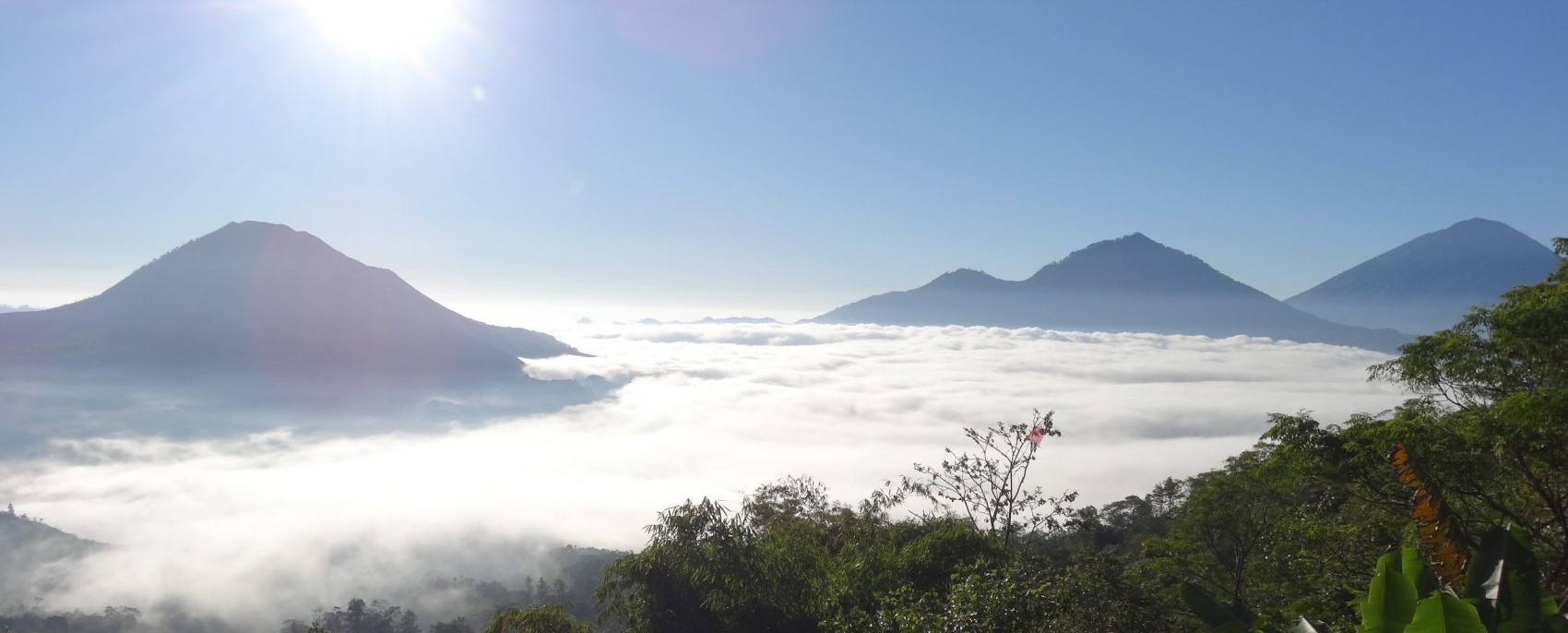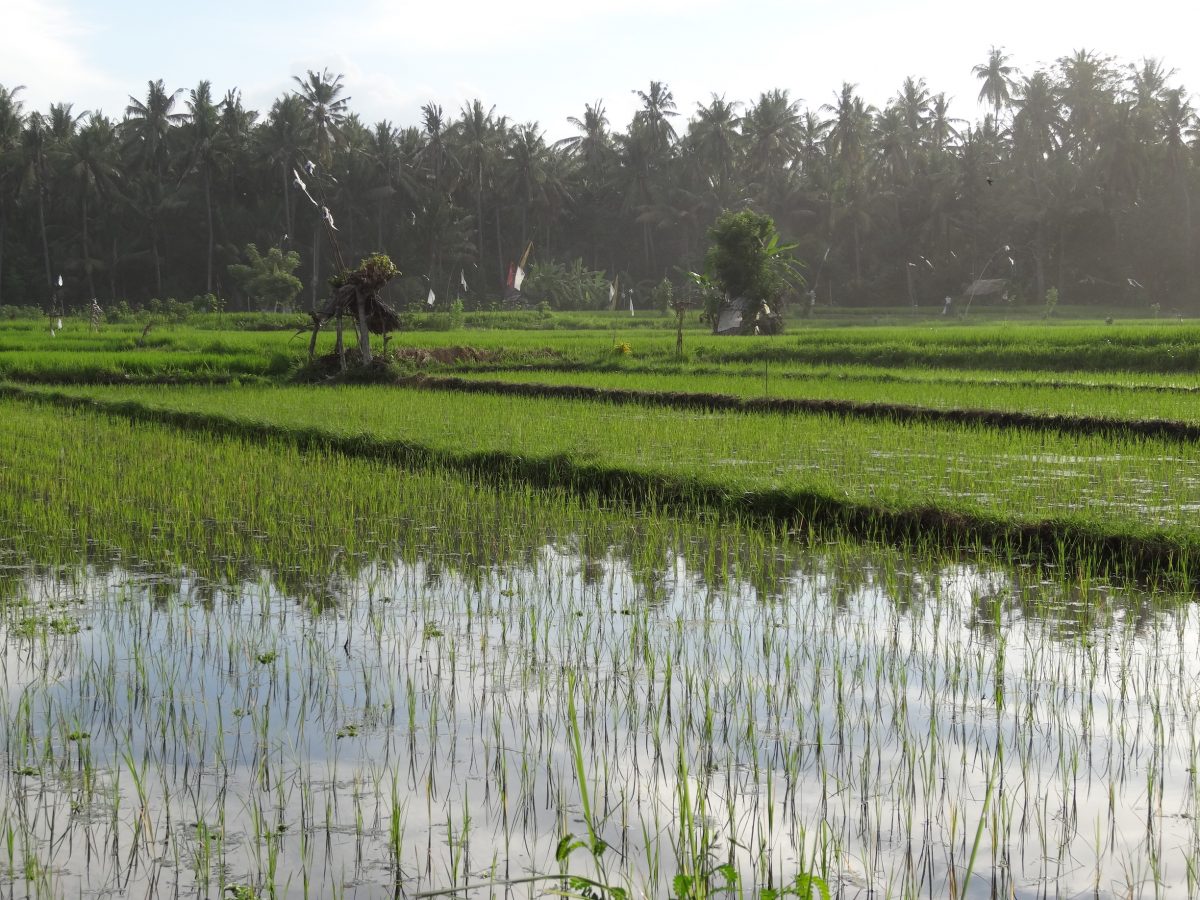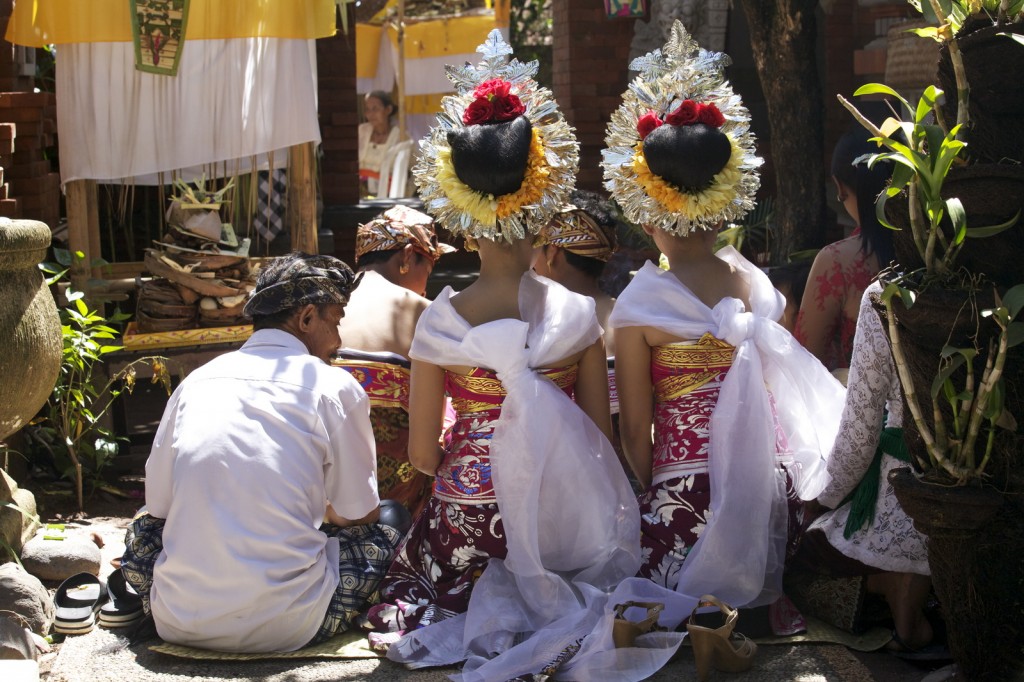
Bali, the island of the Gods and Demons in the Indian Ocean, always fascinates its visitors. The special energy of this Hindu island with all its rituals and traditions, accompanies its inhabitants from birth to death and further on. It is the basis of the families and the village communities. It creates the order of the family life and the ethic guidelines of the whole nation.
Bali belongs to the Lesser Sunda Islands and has a size of 5561 km2 and a population of 4,5 million. From north to south the island is 95 km long and from east to west 145 km wide.
The climate is tropical. The temperatures by the coast are between 24 and 32 degrees and most of the time there is a pleasant breeze. The wet season is from November to March, which is very smooth compared to other monsoon areas. The north coast is in the shadow of the rain and has an average rainfall of only 1000 ml, whereas in the mountains they can get up to 3000 ml rain.

The naturally warm-hearted people with their smiles in combination with tropical vegetation, gardens of Eden, beautiful rice terraces, countless temples and temple dances, impressive volcanic landscape, beaches and the handicraft of the artists and healers, makes this island unique.
Most of the mountains in Bali have a volcanic origin and about ¾ of the island is covered with volcanoes. The volcano Gunung Agung (“Big volcano”) is the highest volcano on the island of Bali measuring 3031 meters. In the Balinese culture Gunung Agung is home to all the gods. Furthermore this volcano is the center of the Balinese coordinate system.
The volcano last erupted in 1968 where 2000 people were killed and countless villages and (rice) fields were destroyed. West of Agung joins the 10 km wide caldera of volcano Batur massif with Gunung Abang as its highest elevation at 2153 meters. Inside the crater lie mount Batur (1717 m), a young cone which erupted four times in the 20th century, and the crater sea Danau Batur.

Bali is the only region next to India, Nepal and Mauritius that has a majority Hindu population. Most Balinese people belong to the Agama Hindu-Dharma religion, which is the “Balinese version” of Hinduism. On the island, religion and life are closely intertwined: religion is life and life is religion. Religious ceremonies and celebrations are part of everyday Balinese life from birth to death. Even beyond one’s death they play an important role. It is these traditions and ceremonies that hold Balinese families together and structure communities. They come into life with the foundation of every village and function as moral and ethic standards, which the people have to live by and act according to. All public holidays, gatherings and celebrations always begin with a temple ceremony.

When the Indian Brahmans brought the Hindu gods to Bali in the 10th century, the Balinese culture was already highly developed. Therefore, the Balinese did not replace their religion with the Indian belief system but rather integrated elements of the Indian religion into their own. The new cultural influences from India did not push away existing traditions and ceremonies but rather melted into them, creating an even richer and unique Balinese religion. The belief in the power of nature, the animation of the environment and the worship of ancestors remained and together with the Hindu influences have created a complex, yet harmonious Hindu-Balinese religion.
Bali is also referred to as “The Island of a thousand temples”. In the majority of cases, the temples are decorated elaborately, even those that are far away in more remote areas of the island. Because every temple is carefully looked after and thoughtfully decorated by its people, even the smaller temples can compete with renowned ones. In addition to the big and small temples each house has a family temple and you will find countless little versions of a temple at street corners, Banyan trees etc. Sometimes a simple offertory box is used.

Bali, the island of the Gods and Demons in the Indian Ocean, always fascinates its visitors. The special energy of this Hindu island with all its rituals and traditions, accompanies its inhabitants from birth to death and further on. It is the basis of the families and the village communities. It creates the order of the family life and the ethic guidelines of the whole nation.
Bali belongs to the Lesser Sunda Islands and has a size of 5561 km2 and a population of 4,5 million. From north to south the island is 95 km long and from east to west 145 km wide.
The climate is tropical. The temperatures by the coast are between 24 and 32 degrees and most of the time there is a pleasant breeze. The wet season is from November to March, which is very smooth compared to other monsoon areas. The north coast is in the shadow of the rain and has an average rainfall of only 1000 ml, where as in the mountains they can get up to 3000 ml rain
These originally warm-hearted people with their smiles in combination with tropical vegetation, gardens of Eden, beautiful rice terraces, countless temples and temple dances, impressive volcanic landscape, beaches and the handicraft of the artists and healers, makes this island unique.
Most of the mountains in Bali have a volcanic origin and about ¾ of the island is covered with volcanoes. The volcano Gunung Agung (“Big volcano”) is the highest volcano on the island of Bali measuring 3031 meter. In the Balinese culture Gunung Agung is home to all the gods. Furthermore this volcano is the center of the Balinese coordinate system.
The volcano last erupted in 1968 where 2000 people were killed and countless villages and (rice) fields were destroyed. West of Agung joins the 10 km wide caldera of volcano Batur massif with Gunung Abang as its highest elevation at 2153 meters. Inside the crater lie mount Batur (1717 m), a young cone which erupted four times in the 20th century, and the crater sea Danau Batur.


Bali is the only region next to India, Nepal and Mauritius that has a majority Hindu population. Most Balinese people belong to the Agama Hindu-Dharma religion, which is the “Balinese version” of Hinduism. On the island, religion and life are closely intertwined: religion is life and life is religion. Religious ceremonies and celebrations are part of everyday Balinese life from birth to death. Even beyond one’s death they play an important role. It is these traditions and ceremonies that hold Balinese families together and structure communities. They come into life with the foundation of every village and function as moral and ethic standards, which the people have to live by and act according to. All public holidays, gatherings and celebrations always begin with a temple ceremony.
When the Indian Brahmans brought the Hindu gods to Bali in the 10th century, the Balinese culture was already highly developed. Therefore, the Balinese did not replace their religion with the Indian belief system but rather integrated elements of the Indian religion into their own. The new cultural influences from India did not push away existing traditions and ceremonies but rather melted into them, creating an even richer and unique Balinese religion. The belief in the power of nature, the animation of the environment and the worship of ancestors remained and together with the Hindu influences have created a complex, yet harmonious Hindu-Balinese religion.
Bali is also referred to as “The Island of a thousand temples”. In the majority of cases, the temples are decorated elaborately, even those that are far away in more remote areas of the island. Because every temple is carefully looked after and thoughtfully decorated by its people, even the smaller temples can compete with renowned ones. In addition to the big and small temples each house has a family temple and you will find countless little versions of a temple at street corners, Banyan trees etc. Sometimes a simple offertory box is used.


